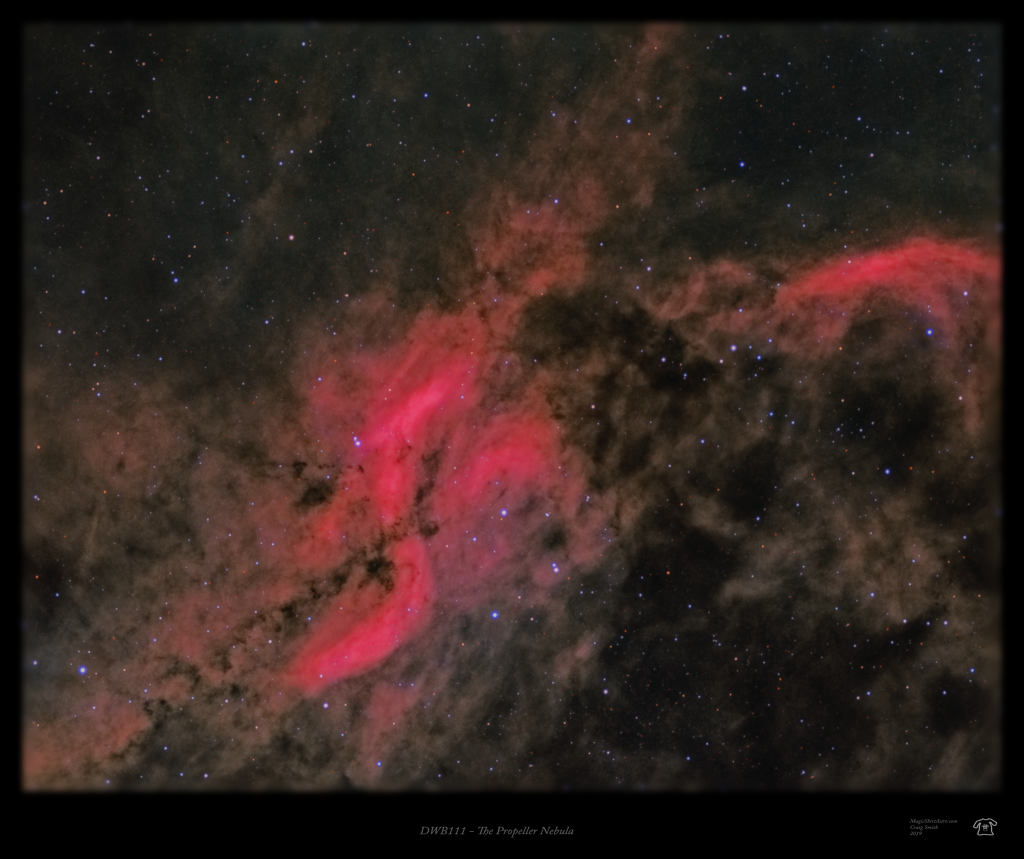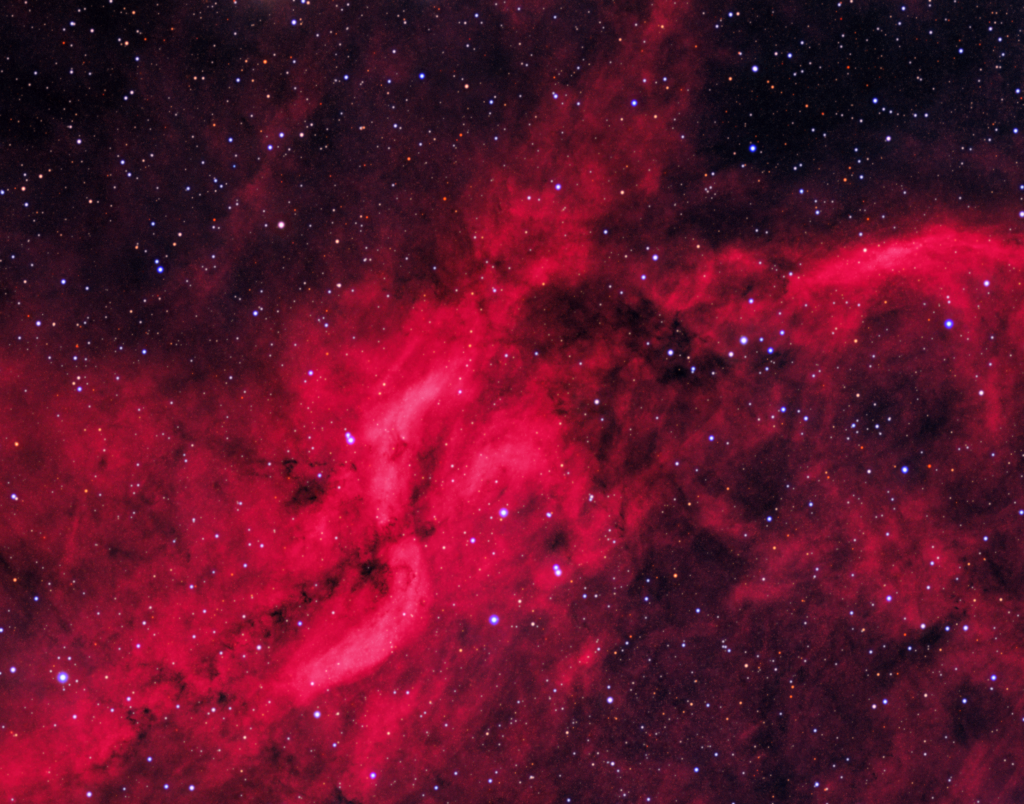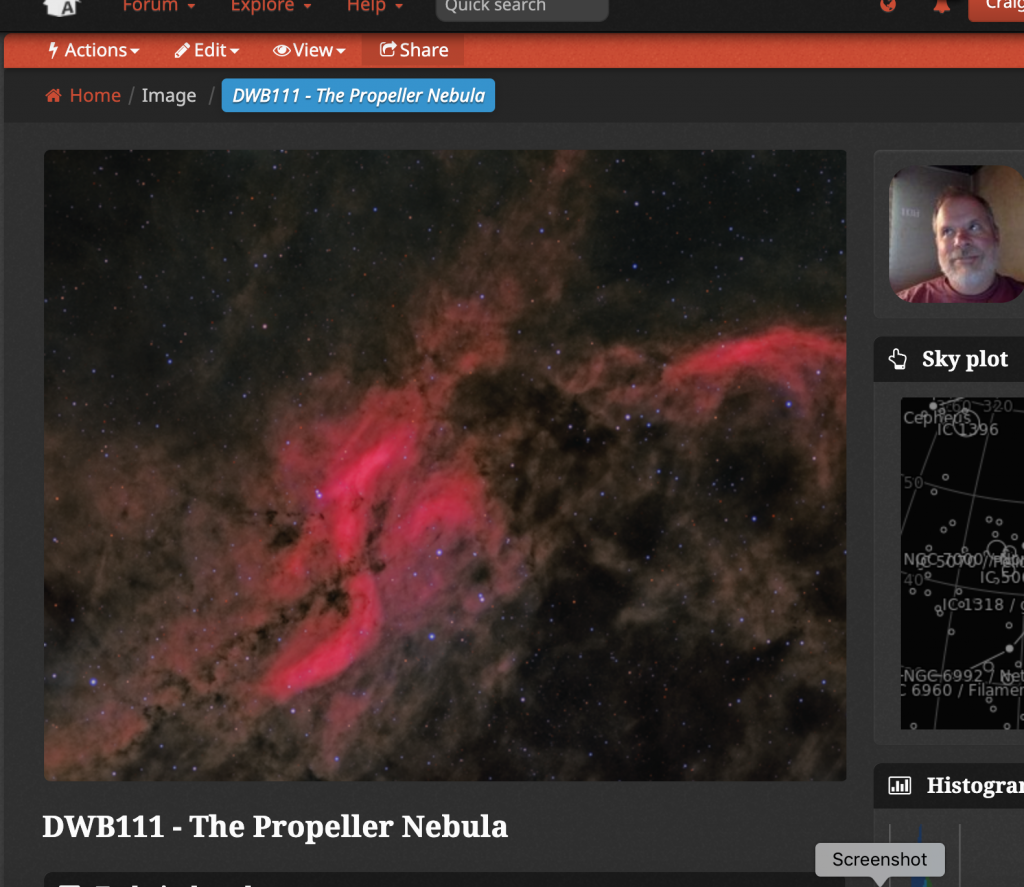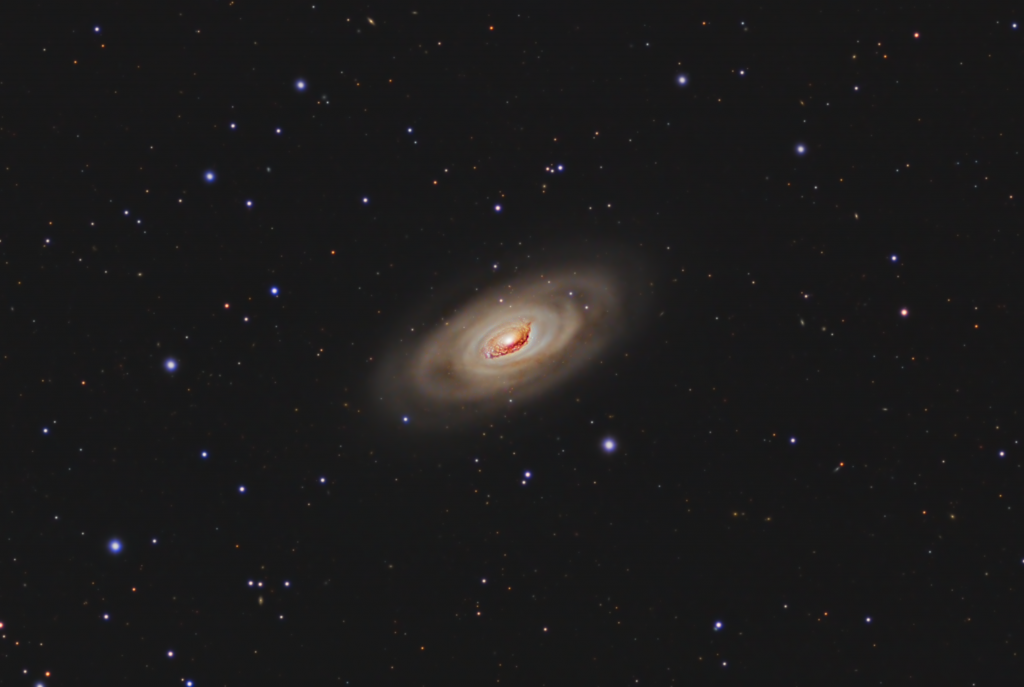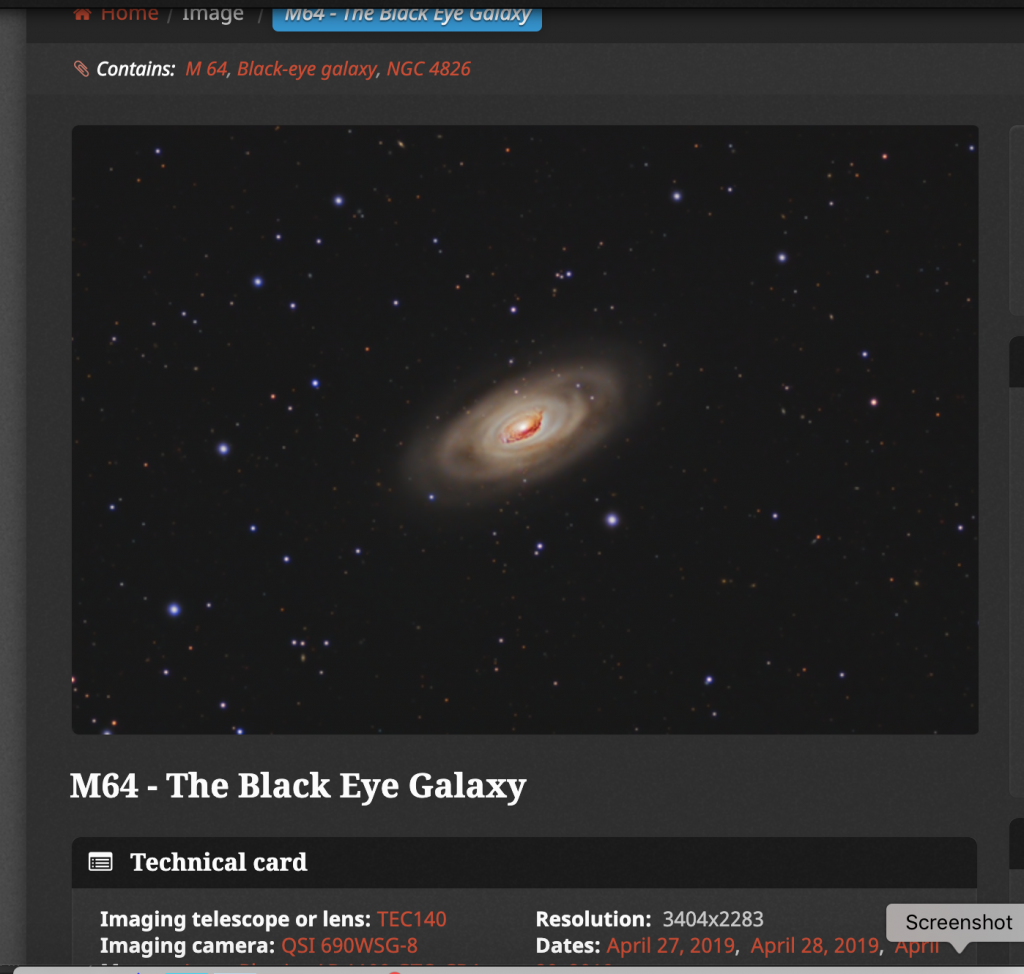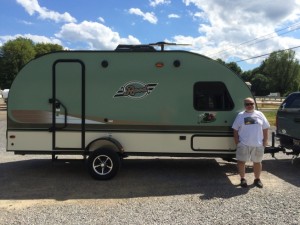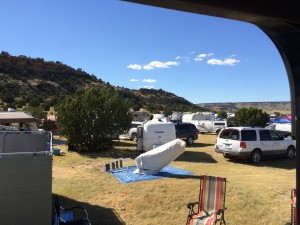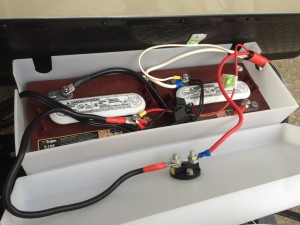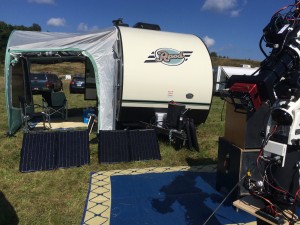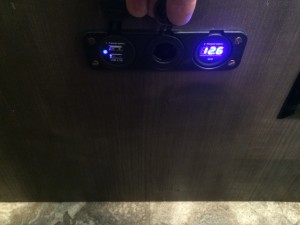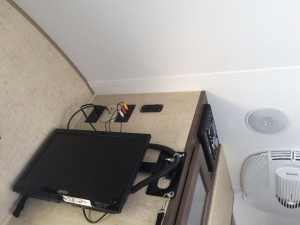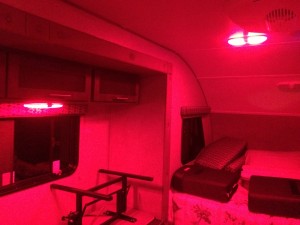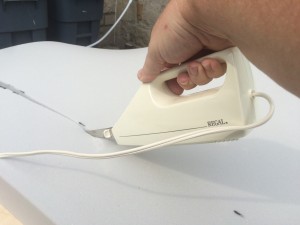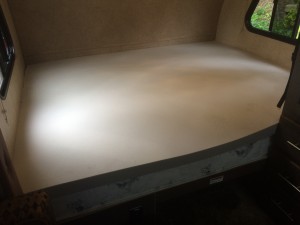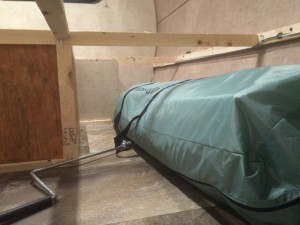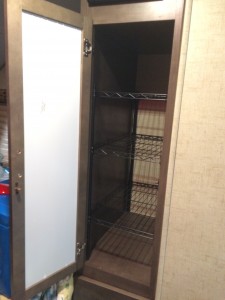I drafted this wrap up of some of my ramblings that I started in TGAA Part 1. Much of the information is still relevant, so I am going to post it just in case it is useful to somebody. Even though I am no longer a “Podder” I still keep an eye on the user’s group. If you want so share any thoughts or ask any questions, please hit me up over at the FaceBook rPod owners group!
Dry Camping
As some of you may know, one of the main reasons I purchased an r-Pod was to allow me to move out of my astronomy tent and into a more comfortable surrounding at my astronomy outings. These outings are an odd version of dry camping… There are no hook-ups, but there are bathrooms, showers, and available meals. There is usually electricity, but you are only allowed to hook up your telescope gear to it, and not your trailer.
So off the bat, for a small trailer, the r-Pod has a nice advantage with the 36 gallons of fresh water as well as the 30 gallons each of gray and black water storage capacity. I tried to help it out by ordering it without a battery and installing two 6-volt Trojan T-105 golf cart batteries (see Part 1) and a second 20 lb propane bottle. Also, I purchased two 100 amp solar panels to keep those batteries charged up. And finally, if all fails, I can charge up with a Honda 2000 Companion generator.
So how has it worked out so far? To be honest, under the conditions I described, it has been overkill. My longest stay, so far, has been from a Thursday night to the second following Sunday… so 10 nights if I counted right. Also, my grown son was staying with me… so there were two of us. Granted, I have been pretty lucky with the sun in my outings, but my batteries have barely come off fully charged (lowest reading was 12.5 volts). We were mainly using the battery for lighting, music, and charging computers and IOS devices (so admittedly, not very taxing other than the computers). The first propane bottle lasted through that trip and another shorter trip. It was running mainly the fridge, but also the hot water tank, occasionally. My son and I had a gentlemen’s agreement about no solids in the black tank. Toward the end of the 10 days the fresh water indicator was drifting toward having only one indicator light on, but on the last day, I still took a shower to ensure there was plenty of water in the gray tank. There was still a substantial amount of fresh water in the tank when I finally drained it.
So yes, we are a couple of guys, and we were drinking bottled water and making coffee from bottled water, and showering for the most part in a bath house. But still, the r-Pod performed really well in that hybrid dry-camping set up.
Towing
“We pulled our trailer Key West to Anchorage… we couldn’t even tell it was back there.”
– someone on every forum you’ve ever visited
I don’t know who those people are, but I will be generous and assume it is something of a literary exaggeration. My tow vehicle is a reasonable size. It is a 2011 GMC Sierra, 1/2 ton truck with extended cab, eight-foot bed, 4wd, factory trailer package, and a six-speed transmission. The truck weighs over 6000 lbs empty. It is a substantial vehicle… and I will say that I know the trailer is back there. It doesn’t feel unsafe, and to date, it doesn’t tend to sway. But it is a drag, it does (along with the cargo I always have along) drag down the rear of the truck significantly. And my typical highway mileage of over 18 mpg fell to 12, best case. 10 is more realistic.
With the “hauling mode” enabled, the truck pulls along the trailer at pretty much any speed you would want as long as the grade isn’t too steep. The trailer seems well-behaved and under control. But the steering is lighter than normal, not to an unmanageable amount, but also still noticeable and to me, slightly unpleasant. To be honest, I thought this was a huge problem until I saw some of my friends from Texas when I was at the OkieTex Star Party last fall. Compared to me, I think some of those good old boys will never have to use their high beams. And when we packed up our rigs and headed out to breakfast on the last day of the event, I could barely keep them in sight. So I guess maybe I worry too much!?!?!?
Airbags/Super Springs
Once I purchased the trailer and before I picked it up, I decided I was going to get air bags. Since the back of my truck is always loaded down with astronomy gear even before the trailer is hitched up, I wanted to help the truck out. I had visions of air bags, a compressor, and standing in the field next to the hitched up trailer pressing my key fob to activate the compressor and level everything out. This seemed like it would be as cool as it gets (I still kind of feel that way). But, the guy at the truck outfitter told me it was a huge mistake. He told me that what i wanted was Super Springs. Helper springs that don’t do much when you are unloaded, but kick in more and more as the load increases. I took him at his word since the helper springs were about 1/4 of the cost of the airbag setup I lusted after.
I like the springs. I think they do what they are supposed to do. They actually have three settings, and initially, I had them at the lowest setting (least helping), then on my last trip I had them on the middle setting. I think that on the next trip where the truck is fully loaded, I will try the highest setting. The downside to this is that each higher setting also bumps the rear end of the truck up a little bit when it is unloaded… and I don’t care for that.
So these are working out, I think. But I often still wish I would have gotten the remote controlled air bags. If they worked reliably and didn’t turn out to be a maintenance headache, I think they would be great.
E2 trunion WDH
I also outfitted my rig with an E2 Trunion-style Weight Distribution Hitch. “No” to your first question. I don’t think I need a WDH. In fact, for short little pulls around home, I don’t even use it. But for longer highway pulls, even though it isn’t needed, it certainly improves the ride. It makes the trailer feel much better connected to the truck. The trunion model (and perhaps other models, too) incorporate sway control… and not the kind that you have to unhook when you back up. Again, it is just my opinion, but this change made a substantial improvement in the handling of the entire rig. Again, too, I am pulling pretty far sometimes… I have taken the trailer on three trips and have 5500 miles on it, already.
Tires
I know this is a topic which evokes strong feelings among many. Me too, I guess. On the first two trips, I disliked the gas mileage, I disliked the lighter feeling in my truck’s front end, but what I disliked the most of all was feeling like I was the absolute slowest thing on the highway. It drove me nuts. To find myself in this position, all I had to do was follow the speed rating of my tires, which for me, with hauling mode enabled on my truck, meant setting the cruise control at about 62-63 mph, so that I always stayed below 65 mph on my Load Range C ST radial tires.
After the second trip I took and before the third, I ordered replacement tires, Load Range D, bias-ply tires from eTrailer.com. Even though these are still ST tires, as long as they are loaded below capacity but supplied with additional air pressure (but still less than the rated allowable pressure of the tires) you can increase the maximum speed rating. So in my case, the Load Range D tires ran run at up to 65 psi. But for my trailer, they would be run at 50 psi. If I increase the pressure to 60 psi without increasing the load, my max speed rating goes up to 75 mph. More than enough for me! At least this is how I understand this to work. Your mileage may vary. Also, as an aside, and I think this may be more about the bias ply than about the load rating, but when towing the trailer with these new tires, it just appears more stable. I know that radials are supposed to flex and absorb the road, but the trailer just seemed to be bouncing around much less on these bias tires. Could just be my imagination.
Anyhow, this made all the difference to me and my towing experience. Instead of cruising in the low 60s, I can now set my cruise on 68 or so and be in the middle of the pack, traffic-wise, instead of slower than every. other. person.
I know lots of people will say “what’s your hurry?” And to those who feel that way, I honestly and truly respect your feelings and your opinion. But I feel like I have a very heavy TV, a good hitch, and often, I am on my way to get somewhere to spend my time there instead of taking my time along the way. To each his own, I think.
To me, this is the single best thing I have done to the trailer, so far.
R-Dome/Visor/Clam
The Dome is Home
– a whole lot of folks who have the r-Dome
Another item that seems to stir Podder’s emotions is the good old r-Dome. I have pretty mixed feelings about an r-Dome. I will try to share why in an unbiased way. I currently own an r-Dome, a PahaQue visor, and a Clam, so I can speak with a little experience with all of them.
First, I will say when all is set up and the weather is reasonably fair, I think the r-Dome is terrific. It provides a reasonably secure and weather tight place to keep more stuff. It gives you more room to live, and if needed, more room to sleep. It provides something of a porch instead of stepping from the trailer to the un-sheltered outside. And the options are for opening various windows and doors makes it all really versatile.
-
At the same time, for me and my needs, the r-Dome does have some disadvantages:
- One of the big ones for me is that it takes some effort and time to both set it up and to take it down and stow it away. I hear some impressive record-setting times for setup, but I think that one person would have to keep pretty busy to have it set up and staked down in 30 minutes. And, it doesn’t come down any faster that it goes up.
- Further, there are some impressive stories about how much wind the dome can withstand, but for me, much like a tent, there is constant fiddling and tightening if it is pretty breezy. Some people don’t mind that sort of thing and consider it part of camping. And again, I respect their feelings and position. I feel like I moved from my tent to a trailer so that I didn’t have to listen to my shelter flapping and wonder whether I needed to do something. You might say, “if it gets windy, you could always just take it down, right?” Indeed. But, if you are using the dome as an overflow storage area, then taking down the dome also involves stowing that stuff away. The last time I had my dome up was in the Oklahoma Panhandle. It was set up well, staked down well, and the poles tightened well. It got breezy (gusts over 20 mph, but I don’t know how much over) and even with the flaps all open so the wind could go straight through it started pulling the dome out of the Keder rail. Not at the ends, but in the middle between the support poles. So I had the experience of taking it down in a stiff, gusting breeze.
- And finally, there is the expense. Many folks have a dome included in the price of the trailer, and that is great. If not and if you have to try and buy one, I think that they retail for over $700. That, in my opinion, is a lot of money for what you get.
PahaQue Visor
The PahaQue Visor is a cool little accessory. I happened to pick mine up at the PahaQue closeout rack, so I got a pretty good deal on it. The trim is maroon-ish purple… so it brings out the color in my fishing frog logo!
The visor is lightweight and doesn’t take up much room in the storage bay. It is essentially self supporting by using the Keder rails, both above and below. I only have had mine up twice, but already, by the second time, it only took 10 minutes to set up… including finding the ladder. It is a neat little design and pretty cool, but if it has a drawback, it is that it is not very big. If the door of you trailer is facing south, the visor isn’t going to provide much, if any, shade. But it is nice to have a little roof area over the door and on that side of the trailer. And it is so easy to set up it is worth doing, even if you only plan to have it up for a few hours.
the Clam
I only just got my Clam, and have only set it up (partially) in my living room. It looks like it is going to be great for me. It is pretty good sized, but it also sets up very quickly. Really, it just takes 5 minutes to get it out of the bag, lay it out, pop the 5 sides and the roof, and set it in place. A few stakes are optional, I suppose. It only takes that long to take down, too. It just folds up, bundles together, and it is ready to stuff back into the storage bag. Hopefully, I may have more to say about this after I actually use it.
Problems with my r-Pod
Honestly, if you read some of the posts on the web about R-Pods, other Forest River products and really, about all RV’s, you have to apply some reason. Otherwise, we would all be foolish to ever purchase an RV or even more foolish to ever take our lives in our hands by, say, hooking up and leaving the driveway.
I don’t say this to try to downplay the very real problems that some have experienced. I am just saying that perhaps you read about all of the bad experiences and few folks bother to write about the positive ones. Well, anyhow, that is my hypothesis.
In part 1 of this post, I wrote about some of the mods that I have done to my trailer. Here are a few of the problems that I have experienced. These are outside of the normal dust, dirt and screws laying behind every wall and in every nook and cranny. I also don’t include items like crappy speakers, or the fact that the Jensen is installed so high that the display always looks blank unless you stand on a stool (I am sort after all).
Warranty Repairs:
- Fantastic Fan – My original Fantastic Fan was wobbly and out of balance. It sounded like it was hitting something when run on high. I wasn’t sure if they were all like that, but I complained, anyhow. The dealer not only replaced it, but replaced it with a different model. Boy, what a difference. It made appreciate how bad the original one really was.
- Window Leak – Like others, my 179 came with a rear window leak pre-installed. Whenever it rained and especially when I towed through the rain, water would come in along the bottow of the window and soak the counter top. Initially, I tried adding a bit of caulk along the upper edge, but it made no difference. The dealer said they “re-caulked” the window. I couldn’t really see what they did. But, it hasn’t leaked since.
- Hitch Light – My hitch light worked the first time I used it. Then not again. One day, I pried the lens off and wiggled things around and it worked again. Until it was dark. I told the dealer about it and they “fixed” it. Not sure what they did, but it has worked every since, too.
Non-Warranty Repairs
- Hitch Adjustment – When I took delivery of the trailer, the locking device on the trailer was adjusted too tight. At the dealer, I had to put the truck in gear and lean forward so the technician could get the hitch closed. What did I know about this being an issue? The the next time I hitched the trailer, it was the same problem. I was really reluctant to adjust the locking mechanism, but I sucked it up and went ahead. As it turns out, it took a very small adjustment to make it work easily and reliably. And it is still strongly latched. It was just adjusted incorrectly at the factory.
- Brakes – The brakes are an ongoing story as of this writing. I am unconvinced that the trailer brakes work like they are supposed to. I have gone through many iterations, but I am still not done. First, on my GMC truck, the output from the integral brake controller was simply not hooked up (nor was the charging wire). Even so, once hooked up and with the brake output set to its highest output, activating the trailer brakes from the brake controller results it little to no discernible braking coming from the trailer. The GMC dealer has checked the truck output and says it is operating correctly. The trailer dealer says the trailer brakes are operating normally (I suspect that their test may be to pull the pin on the emergency brake, which does, in fact, lock up the trailer brakes). I asked them to listen at the trailer brakes while I applied the truck brakes, and they assured me they could “hear” the trailer brakes activating. My latest hypothesis is that the trailer brakes are grossly out of adjustment. So much so that they have never been able to “self-adjust” their way to where they should be. Of course the trailer dealer says they are fine, its a big truck, the trailer can’t slow down the truck, anyhow. I don’t quite follow that, though. It seems to me that the size of the TV shouldn’t matter as far as whether the unloaded trailer wheels lock up or not. Anyhow… hopefully more to come on this.
I guess this is all for now. Hit me up in the FaceBook group if you have any questions or comments or suggestions!
